Have carillon, will travel
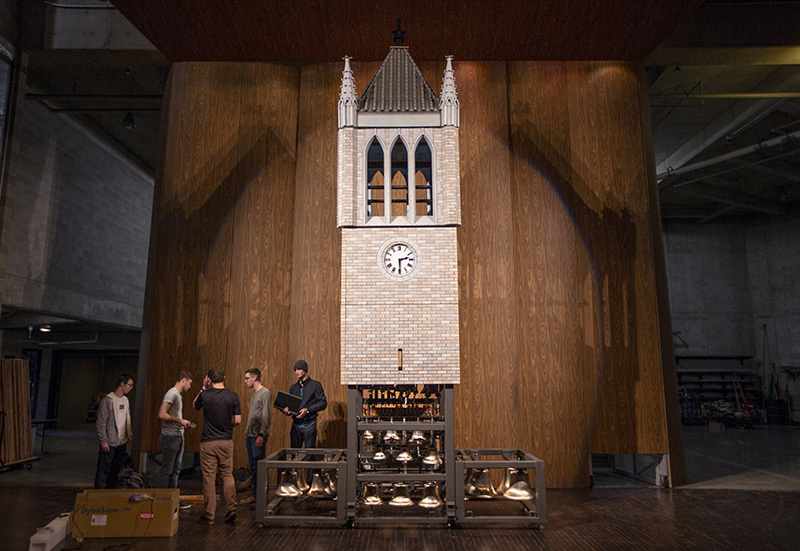
Capstone students helped assemble the campanile-carillon model for its debut performance at Stephens Auditorium. Photos by Christopher Gannon.
University carillonneur Tin-Shi Tam and her students now can take their show on the road. A one-fifth scale playable model of Iowa State’s iconic carillon and campanile was unveiled at an Oct. 27 celebration concert, where Tam played "Bells of Iowa State" and a commissioned "Fanfares, Athems, Peals" that incorporated the ISU Symphony Orchestra and alumni chorus.
"This is a trademark design," Tam said. "It's the first of its kind in this configuration, with this concept."
The model will be used for special events, guest performances and educational outreach, a nod to Iowa State's land-grant mission. Tam said for-hire engagements -- for example, weddings -- also may be possible.
"This can go anywhere the road can take us, honestly," Tam said. "The Student Carillonneur Leadership Council will be really involved in doing the performances and all the logistics."
A group effort
Tam, Cownie Professor of Music, shepherded the "ambitious project" through four years, more than 6,500 emails and countless meetings with the students helping to design and build the model. She is quick to deflect the attention to everyone else who helped make the model a reality.
"This cross-disciplinary project could not have been accomplished without the dedication, patience and leadership of the many students, faculty and staff involved. Thanks also to sponsors in sharing our vision to spread Cyclone traditions across the state and throughout the nation," Tam said.
At the top of Tam's thank-you list is Jim Heise, associate teaching professor in mechanical engineering. He has managed the project since its inception, guiding eight capstone classes (so far) that worked on the model. As an ISU grad who, as a student, campaniled with his wife of 37 years, it's a project close to his heart.
"It all has special meaning to me," he said. "It's a labor of love. Literally."
Nearly 100 capstone students have been involved in the multidisciplinary project. Work on logistics -- for example, containers for packing and moving the facade pieces -- is in store for Heise's next capstone class.
"I give the students a choice about which project they'll work on, and every team gravitated toward this one," Heise said. "They're emotionally attached, just like I am."
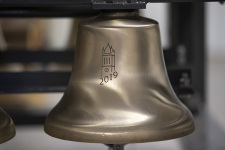
The model's 27 bronze bells are engraved with the dedication year and sponsor names.
The model
The portable campanile-carillon model stands 21.5 feet tall with the tower fully extended, and about 6.5 feet tall when collapsed. The structure's center compartment contains 19 bells, the keyboard and a scissor-lift frame for the campanile facade -- complete with working clocks on all four sides. Two detachable side sections house four bells each.
The model's 27 bronze bells range in size from 15 to 140 pounds. In its entirety, the structure weighs about 2,800 pounds. Heise said it should take a team of two to four people about an hour to assemble or disassemble.
Like the full-size carillon, Tam and her students have a practice keyboard in Music Hall that mimics the model's playing experience. Unlike the original, there are no foot pedals for the model and the 27 bells are played only with the hand console.
The carillon and a poster about the project are on display at Parks Library until Thanksgiving break.
Special touches
Students in electrical, computer and software engineering designed an interactive electronic display like the popular Guitar Hero video game to guide first-time players through songs. The notes of the song cascade down the monitor to a lightbar above the keyboard that indicates when the player should hit the corresponding keys. The visual indicator allows anyone, regardless of expertise, a hands-on experience.
Two benches accompany the model. They were created using wood from an oak tree that used to stand near the campanile. The playing bench is for the carillonneur, the other is a "lovers bench" for campaniling couples on the backside of the model.
"The whole tradition of campaniling is being recognized by this as well," Heise said. "The wooden benches are from a tree that was there when the campanile was built, so it has a history with the university."
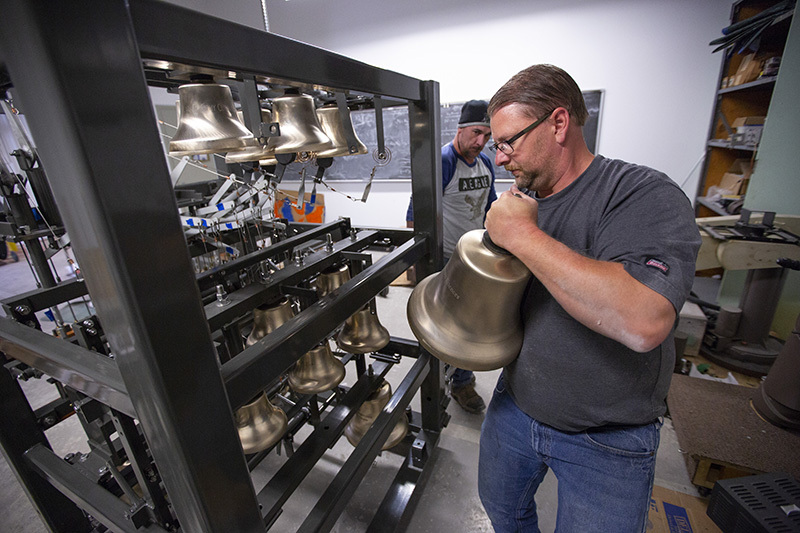
Josh Meeks, right, and Adam Clifton of Ohio-based Meeks, Watson and Co. bell founders and carillon builders, prepare to hang and connect another bell in the center section of the model.
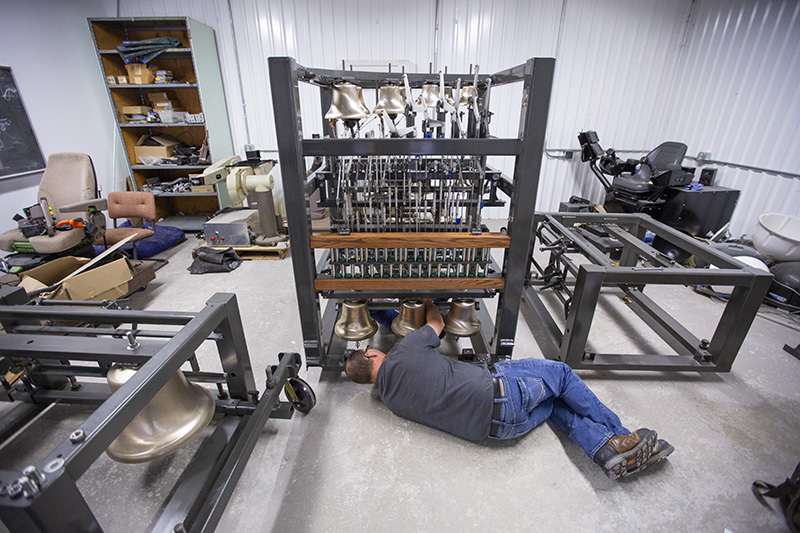
Josh Meeks attaches the lower bells in the center section of the model.
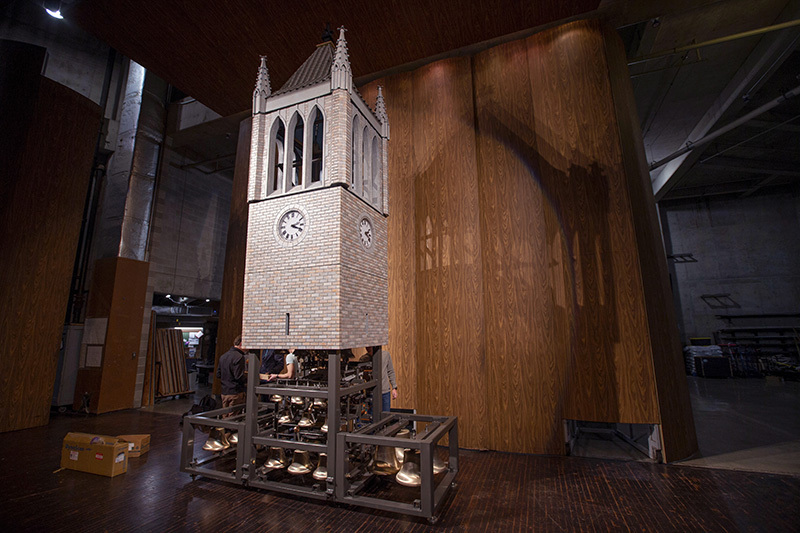
The campanile-carillon model was assembled on the Stephens Auditorium stage for its debut in the Oct. 27 "Bells of Iowa State" celebration.
Related stories
- First bell cast for carillon model, April 12, 2018
- Karaoke with the carillon, Sept. 7, 2017
- Class designs playable carillon model, April 28, 2016
Leaders outline winter partial closing
Iowa State leaders have shared the parameters of a partial campus closing during the semester break this winter. During the week of Dec. 23-27, the university will reduce its services when many external organizations and businesses also operate at reduced levels. On the heels of Dec. 20-21 graduation events, it's also the first of three weeks that separate fall and spring semesters.
Including two weekends (Dec. 21-22 and Dec. 28-29) and two university holidays (Dec. 24-25), employees who choose to use three days of paid leave (Dec. 23, 26 and 27) can assemble a nine-day break.
The partial closing is not mandatory and isn't intended to limit any unit's operations, said interim senior vice president of operations and finance Pam Cain and interim vice president for university human resources Kristi Darr in a memo this week to administrative officers. But they encouraged campus leaders to review work priorities, scheduled events, research needs and other considerations and approve operating schedules "that will enable staff to take liberal leave and reduce energy costs."
Critical services, including maintenance and some research projects, must continue, they noted. For others, it's all right to reduce service levels to that of a holiday or weekend.
Monday and Tuesday, Dec. 30-31, are regular work days and Jan. 1 is a university holiday. Cain said supervisors should use discretion in approving employee requests for leave this week since it will be business as usual.
What to do now
Cain and Darr wrote that units should work out a plan now for the week of Dec. 23 and share it with their dean, vice president or senior vice president. If offices will close, staff should set procedures for managing incoming messages or an emergency. Units should post planned office closings on their websites by mid-November so visitors, students and others are aware.
Helpful resources
While public safety and facilities planning and management (FPM) will have staff on duty during the partial shutdown, they won't be able to monitor the whole campus all the time. If outside temperatures fall below zero, unit staff should plan to check their buildings periodically. Trouble calls should go to 294-5100 (FPM) or 294-4428 (public safety).
Several background documents in ISU's online policy library can provide answers to supervisor and employee questions as they make plans:
- Staffing Guidance for University Breaks (PDF)
- Frequently Asked Questions: Staffing Guidance for University Breaks (PDF)
Iowa State's practice of a winter partial closing began in 2009, prompted in part by a desire to help employees use furlough days, one strategy that year for meeting a $24 million midyear state funding cut. Energy savings in closed buildings was another goal. Partial closings of various lengths have occurred every year since.
Wanted: Feedback on campus facilities and spaces
A collaborative team developing a strategic facilities plan is seeking input on how the campus community uses Iowa State's buildings and spaces. Input is being sought from faculty, staff and students during three come-and-go open house sessions being held Nov. 6-7.
"We want to understand what people's experiences are in the facilities they use at Iowa State," said Sarah Lawrence, campus planner in facilities planning and management (FPM). "Facilities have the ability to promote academic success for students, promote professional success for faculty and staff, and support research."
With help from the Ayers Saint Gross (ASG) planning and design firm, FPM is partnering with the academic and student affairs divisions to develop a strategic facilities plan to guide decision-making on future investments and improvements. Lawrence said the open house sessions are part of the assessment phase that also includes data analysis and discussions with units and focus groups.
"The assessment focuses on understanding the quality and quantity of our facilities and understanding whether they are doing their job to support success," Lawrence said. "We're also having conversations about future trends and changes in teaching pedagogy."
Three chances to participate
The open house sessions will add a qualitative layer of information to quantitative data. Lawrence said planners want to hear how the campus community uses facilities, engages with the spaces and moves through campus.
Participants can supply feedback using stickers ("dot voting") or post-it notes (for open-ended answers) to respond to questions posted on display boards. Members of the team working on the strategic facilities plan also will be available to answer questions and collect feedback.
"By speaking with the campus community, we can get different information than what we see in data reports that don't speak to what it's like to work and learn in those spaces," Lawrence said.
Refreshments will be provided at the open house sessions. Lawrence said with the drop-in format, it should take participants no longer than five minutes to answer the questions, but they are welcome to stay as long as they wish. The open house sessions are:
- Wednesday, Nov. 6, 8-10 a.m., Veterinary Medicine commons
- Wednesday, Nov. 6, 4-6 p.m., Union Drive Community Center second floor
- Thursday, Nov. 7, 11 a.m.-1 p.m., Memorial Union Pine Room
What's next
Using information gathered during the facility assessment phase, ASG will develop scenarios that include an investment strategy for the strategic facilities plan team and campus community to weigh in on. A final plan is expected in early 2021.
"We'd like to understand how we can make changes and reinvest in the facilities that we have, so we can continue to offer a world-class education to our students and provide a high-quality working environment for our faculty and staff," Lawrence said.
Campus interviews for registrar finalists begin next week
Four finalists have been identified in the search for Iowa State’s next university registrar, and they'll interview on campus in November.
- Candidate 1, Nov. 3-4
- Candidate 2, Nov. 4-5
- Candidate 3, Nov. 12-13
- Candidate 4, Nov. 14-15
Candidates' names will be announced one business day before their visit. The candidates will meet with faculty, staff and stakeholders. They'll also hold an open forum at which they'll address the question: How can the office of university registrar best support Iowa State’s mission and enrollment management? Forums will be held in the Memorial Union from 11 a.m. to noon on the second day of each candidate's visit:
- Monday, Nov. 4, Campanile Room
- Tuesday, Nov. 5, Soults Family Visitor Center
- Wednesday, Nov. 13, Soults Family Visitor Center
- Friday, Nov. 15, Oak Room
University registrar responsibilities include strategic planning, budgeting, compiling data-driven reports, managing student record information and overseeing transfer student success initiatives. The position reports to Laura Doering, associate vice president for enrollment management in the academic affairs division.
The new registrar will succeed Mark Simpson, who left in June for a position at the University of Texas, Austin. Senior associate registrar Jennifer Suchan is serving in the role on an interim basis.
More information about the candidates, including curriculum vitae and interview itineraries, will be posted on the provost's office search page as it becomes available.
Learning communities work for faculty, too
The first faculty learning communities
- Augmented reality enhancing intercultural competence and second language learning
- The crises of contemporaneity
- Interdisciplinary approaches to research and community engaged coursework in Perry, Iowa
- Sustainable peace
- Water scholars program
It was a chance conversation at a conference.
"A couple of years ago, I was at a conference sitting next to someone from the University of Georgia who was a landscape architect, and he mentioned he was part of a faculty learning community," said Carlton Basmajian, associate professor of community and regional planning and director of the Center for Excellence in the Arts and Humanities (CEAH). "He said, 'Faculty from a lot of different departments get together around a common idea and meet and chat.'"
Basmajian used that talk to help create faculty learning communities at Iowa State when he brought the idea to vice president for research Sarah Nusser. The first five communities have been formed and will work throughout the academic year to address the issues they are researching.
Not your typical research
Although CEAH directs the communities, they are open to faculty across campus. One of the key ideas is bringing together faculty from several colleges and departments with different backgrounds and expertise.
The topic proposals submitted to Basmajian for consideration are broad by design with the hope work will continue even after the community's time concludes. Having faculty collaborate is key.
"There is no expectation of any output. You don't have to write a grant, you just have to get together and talk," Basmajian said. "The key, for me, was no expectations. We wanted to get a group of people together, become friends, learn, talk and maybe you will do something down the line."
Basmajian said the connections could help research in another area as faculty learn what other disciplines can offer. He believes the communities could help new faculty connect on a campus with about 1,900 faculty members.
The accepted proposals received $1,000, including $500 in professional development funds for the organizer.
The first five groups are listed on the CEAH website and are open to anyone who is interested in the topic, Basmajian said.
At the end of spring semester, each group will submit a short report about what it accomplished.
Expanded view
Most big research questions don't adhere to disciplinary boundaries, and the goal is that faculty learning communities lead to looking at issues in new ways.
"I think that benefits the research culture here and people's feeling of connection to the place and each other," Basmajian said. "It can be easy to find yourself siloed because of department responsibilities or committees, and this can help with that."
The learning communities are the latest CEAH effort to enhance its reach. It offers research and symposium grants, and soon will begin hosting monthly "brown bag" events for arts and humanities faculty to gather and present their research and progress.
Proposals
The next call for proposals will likely come in January or early February with an application deadline of April 20, 2020. Those selected will be notified before the end of spring semester.
CyDeas headed for round two
An online platform for crowd-sourcing suggestions and solutions to improve the Iowa State experience launched in February. The feedback mechanism, called CyDeas, already has provided top administrators with food for thought as a campus committee prepares to look at a second round of submissions.
Listening is important to President Wendy Wintersteen and something she's emphasized since day one on the job. Steve Freeman, faculty adviser to the president, is coordinating the initiative to keep the channels open.
"We need CyDeas to keep coming in. The university community has provided some fantastic and creative ideas for improving ISU," Freeman said. "Many of the ideas already were underway in some form, which tells me that Cyclones are on the same page regarding potential issues, and reinforces efforts in those areas. While progress on some improvements will be slow due to budgetary constraints, the feedback that has come in has been extremely valuable."
CyDeas committee
- Steve Freeman, chair
- Jessica Bell, P&S Council
- Brett Sponseller, Faculty Senate
- TBA, student affairs
- Emma Mallarino Houghton, university human resources
- nicci port, diversity and inclusion
Round one
A standing committee met in April to review the first batch of submissions -- 59 had landed in the queue since the online portal's Feb. 21 launch. The committee sorted them by theme and, by consensus, condensed the most relevant into 11 items to move forward. A summary was shared with Wintersteen and university leaders who oversee areas related to them. About a third of the initial submissions focused on parking.
"There's a separate task force working on parking, so we deferred those CyDeas to that committee," Freeman said.
Some submissions were related to efforts already in the works -- for example, a recommendation for a universal first-year experience course for students, which is being developed by a new student onboarding task force. Others -- like adding "CyDeas" to the website index -- had simple fixes.
"Some changes were so easy, we just reached out to make it happen," Freeman said.
Freeman said feedback is helping administrators with discussions and planning. For example, a CyDeas submission about inclusive bathrooms is part of the conversation surrounding Memorial Union renovations.
On the back burner
Ideas that aren't shared with administrators won't be discounted, either. Freeman said additional information or different circumstances may move submissions forward in the future.
Freeman plans to convene the vetting committee again soon to review its second round of CyDeas.
"We have 24 in the hopper to be evaluated," he said. "Keep sending us good ideas. Even if they're ongoing, we still want to hear them. Hopefully, things are being worked on outside of CyDeas as well."
Trice statue will return to central campus next month

Conceptual site plan for the Jack Trice statue north of Beardshear Hall.
The Jack Trice statue will return to central campus in late November, weather permitting. Facilities planning and management and university museums are readying the new site north of Beardshear Hall and south of the Hub. Preparations over the next few weeks include marking off the new location and installing footings and limestone blocks to support the statue. The conceptual site plan (pictured above) provides an approximation of the statue placement and improvements to the area.
The Jack Trice statue has been in protective storage since last spring. The university announced in April the return of the statue to central campus due to construction of the sports performance center and plaza near the statue's location. Prior to its home outside the northeast gate to the football stadium, the Jack Trice statue originally was located between Beardshear and Carver halls (1988-97).
Committee is forming for new Trice artwork at the stadium
An Art on Campus committee is being established to commission a significant art installation at Jack Trice Stadium to further enhance Trice's legacy. The committee will partner with public artist Ivan Depena.
Related story:
- Jack Trice statue is returning to central campus, April 26, 2019
